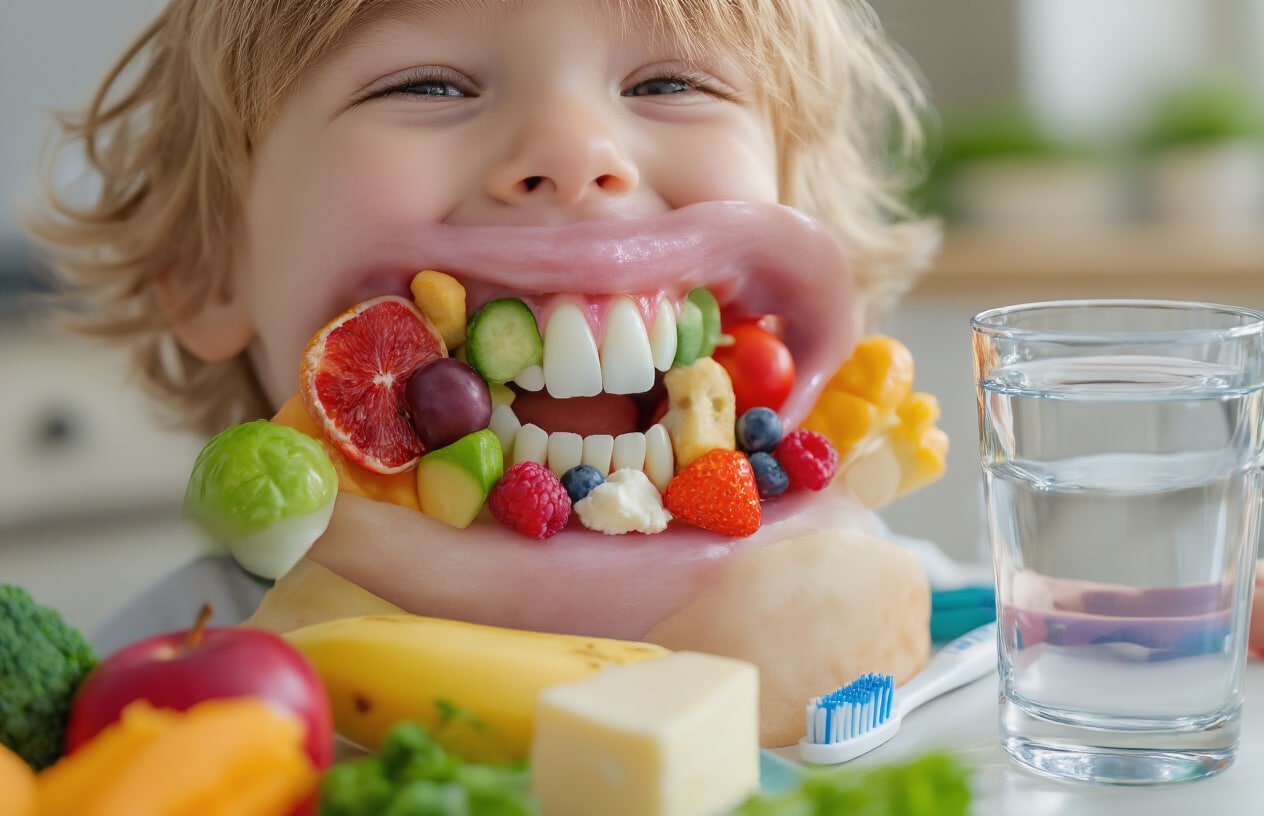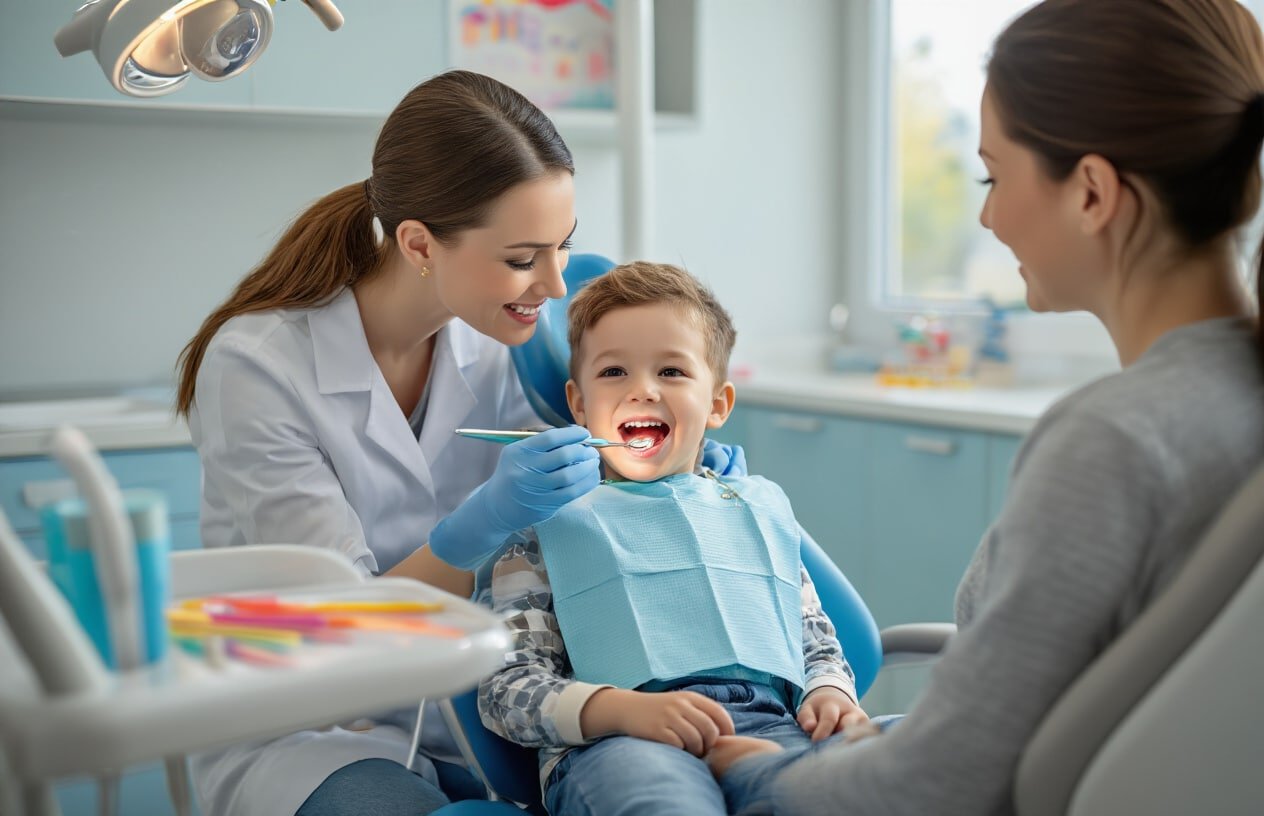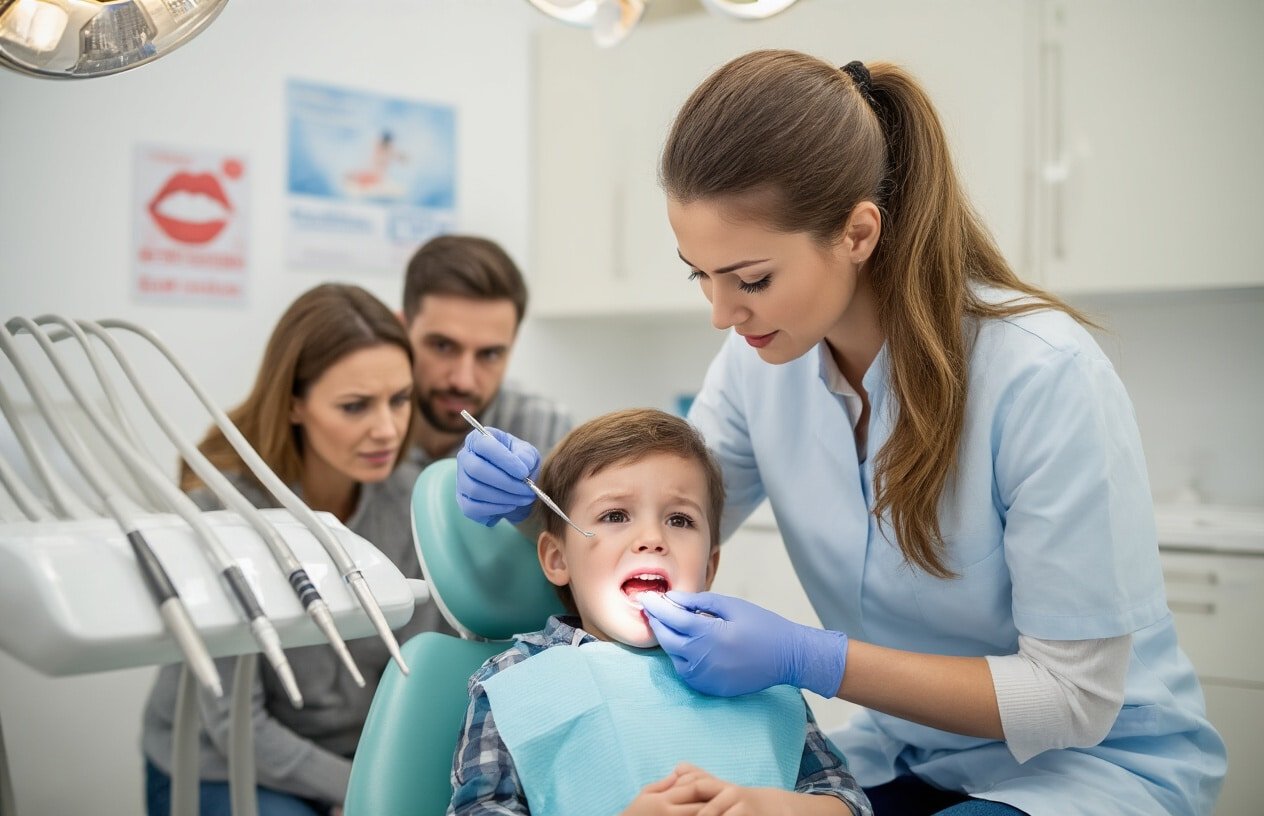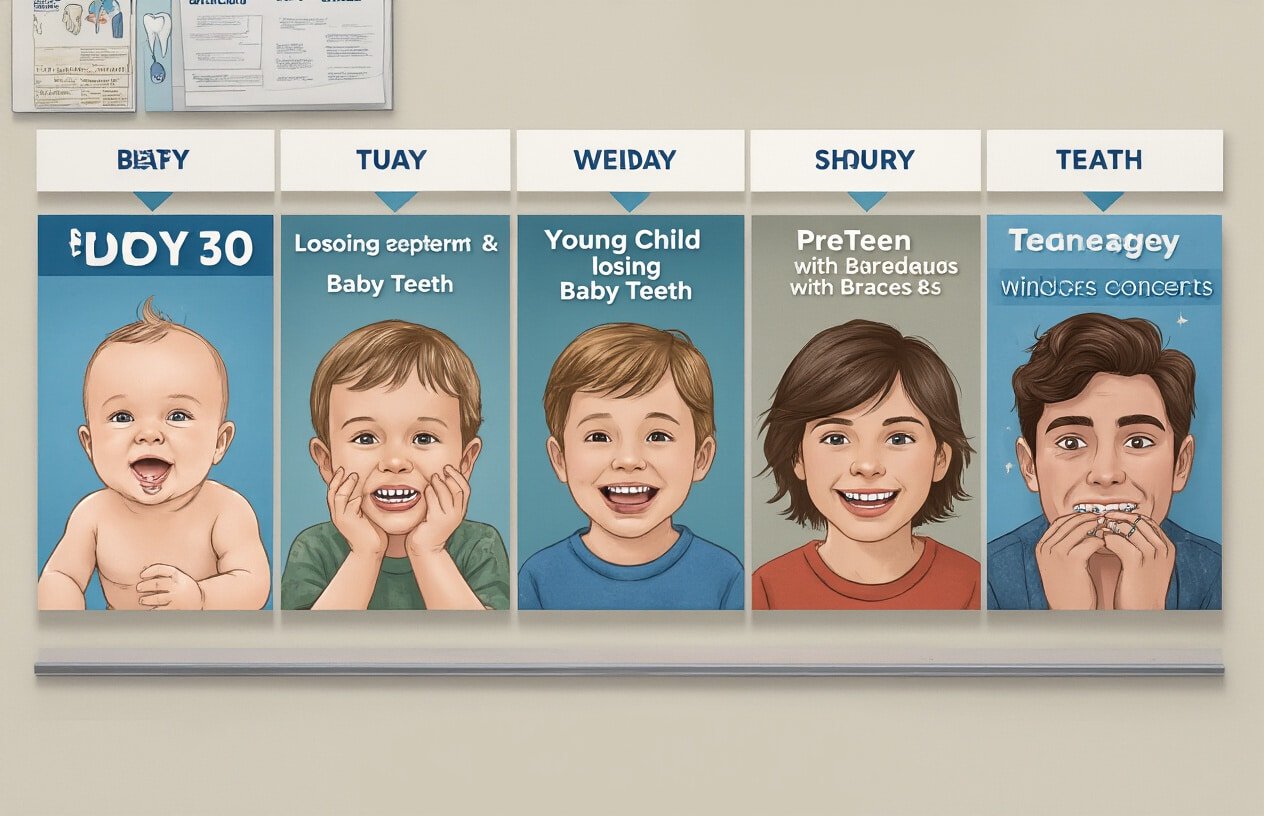Ever seen a 5-year-old have a meltdown over brushing teeth? That battle happens in 7 out of 10 homes every single night. I’ve spent fifteen years as a pediatric dentist watching parents struggle with everything from first teeth to first cavities.
Let me save you years of dental drama with practical advice for caring for your child’s teeth that actually works in real homes, not just dental textbooks.
The foundation of good children’s dental care isn’t about perfect technique – it’s about creating habits that stick without the nightly wrestling match.
But here’s what most parenting blogs won’t tell you: the way you approach those first dental visits shapes your child’s relationship with dental health for decades to come. And that’s where things get interesting…
Start Dental Care Early for Long-term Benefits

A. When to begin brushing your baby’s gums and teeth
Believe it or not, dental care starts before your baby even has teeth! Grab a soft, damp washcloth and gently wipe your baby’s gums after feedings. This removes bacteria and gets them used to having their mouth cleaned.
Once that first tiny tooth pokes through (usually around 6 months), it’s time to start brushing. That single tooth needs care too! Decay can happen as soon as teeth appear.
Don’t wait until your child has a full set of teeth. Every new tooth needs immediate attention – cavity-causing bacteria don’t take days off!
B. Choosing the right toothbrush and toothpaste for different ages
For babies and toddlers under 2, you’ll want:
- A toothbrush with a small head and soft bristles
- Just a rice-grain sized smear of fluoride toothpaste
For kids 2-5 years old:
- Still soft bristles, but maybe a fun character on the handle
- Pea-sized amount of fluoride toothpaste
Don’t grab whatever’s on sale. The wrong toothbrush can hurt tender gums and turn brushing into a battle you don’t want to fight.
And yes, fluoride toothpaste matters from the start. The American Academy of Pediatric Dentistry recommends it as soon as the first tooth appears.
C. Making dental care fun for toddlers
Toddlers fight toothbrushing like it’s their job. Here’s how to win them over:
- Turn it into a game! Set a two-minute timer and make funny faces
- Let them pick their toothbrush (superhero? princess? animal?)
- Brush together so they can copy you
- Create a “tooth brushing dance” with silly moves
- Use a brushing app with characters and rewards
My patients’ parents swear by the “your turn, my turn” approach. Let your child have a go, then you finish the job properly.
D. Setting up a consistent dental routine
Kids thrive on routine, and their teeth will too. Aim for:
- Morning brushing after breakfast
- Evening brushing before bed
- Same location (bathroom step stool facing mirror)
- Same order (top teeth, bottom teeth, tongue)
Skipping “just this once” quickly becomes a pattern. Before you know it, you’re battling a toddler who thinks brushing is optional.
Weekend at grandma’s? Pack that toothbrush! Consistency matters more than perfection.
Remember, these early habits stick around. The child who grows up knowing dental care is non-negotiable becomes the adult who naturally maintains good oral health.
Proper Brushing and Flossing Techniques

Age-appropriate brushing methods
Kids aren’t born knowing how to brush their teeth. It’s our job to teach them, and the technique changes as they grow up.
For babies and toddlers (under 2 years), use a rice-sized smear of fluoride toothpaste on a soft infant toothbrush. Gently brush in small circles, making sure to clean all surfaces. At this age, you’re doing all the work while they’re probably squirming like crazy.
For children 2-5 years, upgrade to a pea-sized amount of toothpaste. Let them “brush” first, then you follow up to make sure all areas are clean. Make a game of opening wide like a lion to reach those back teeth.
For school-age kids (6+), they’ll have better motor skills but still need supervision. A 2-minute brushing with proper technique becomes more important as permanent teeth come in.
When and how to introduce flossing
Start flossing when your child has two teeth that touch – usually around age 2-3. Those tiny spaces between teeth are cavity hotspots that brushing can’t reach.
Most kids lack the dexterity for proper flossing until age 8-10. Until then, you’ll need to help. Here’s how:
- Use floss picks/holders for easier handling
- Stand behind your child, tilting their head back slightly
- Gently slide floss between teeth with a C-shape motion
- Move to a clean section of floss for each gap
Make it part of the nightly routine – never optional. The earlier you start, the less resistance you’ll face.
Tips for helping children brush independently
Kids crave independence, but their oral hygiene shouldn’t suffer for it. Try these approaches:
- Model good brushing yourself – kids copy what they see
- Take turns: “You brush, then I’ll brush”
- Use disclosing tablets occasionally to show missed spots
- Create a brushing chart with stickers as rewards
- Let them pick their toothbrush and flavor of toothpaste
- Stand side-by-side at the mirror so they can mimic your technique
The goal isn’t perfection – it’s progress. Praise effort over results to keep motivation high.
Common brushing mistakes to avoid
Many parents don’t realize they’re making these mistakes:
- Brushing too hard (damages gums and enamel)
- Rushing through the process
- Using adult toothpaste for very young children
- Allowing children to rinse and spit too much (reduces fluoride effectiveness)
- Inconsistent brushing times
- Skipping the bedtime brush (most critical session)
- Using worn-out toothbrushes past their prime
Remember: teeth need cleaning twice daily, every single day. No exceptions for weekends, vacations, or late nights.
Using timers and apps to ensure thorough cleaning
Two minutes feels like forever to a child. Technology makes it manageable:
Musical toothbrushes play songs for exactly two minutes. Sand timers give visual cues for younger kids. And the app world has exploded with options:
- Brushing apps with animated characters that brush along
- Timer apps with rewards and achievements
- Video-guided brushing that shows proper technique
- Apps that track brushing streaks like a game
My patients love “Disney Magic Timer” and “Chomper Chums” – they transform brushing from a chore into something kids actually look forward to.
Nutrition’s Impact on Dental Health

Foods that strengthen teeth
You know what’s crazy? The same foods that make kids’ bodies grow strong also build their teeth. Calcium champions like milk, yogurt, and cheese literally become part of their tooth structure. My pediatric patients with the healthiest teeth? They’re often cheese lovers.
Green veggies deserve serious credit too. Spinach and broccoli pack calcium plus vitamin A that helps heal gum tissue. And crunchy fruits and vegetables? They’re nature’s toothbrushes! Apples, carrots, and celery stimulate saliva and scrub away plaque while kids chew.
Hidden sugars to watch out for
Sugar hides everywhere in kids’ diets! The obvious culprits are candy and soda, but the sneaky ones might shock you. Those “healthy” fruit juices? Some pack more sugar than soda. Granola bars marketed for kids? Sugar bombs in disguise.
Even seemingly innocent foods like flavored yogurt, pasta sauce, and dried fruit can bathe teeth in decay-causing sugars. What makes this worse is how these foods stick around in tiny mouths. That fruity yogurt clings to teeth long after snack time ends.
Healthy snack alternatives for cavity prevention
Swap those cavity-causers for teeth-friendly options. Raw veggies with hummus give that satisfying crunch without the sugar hit. Cheese sticks and plain yogurt (you can add fresh fruit) deliver protein and calcium while actually helping neutralize mouth acids.
My patients’ parents swear by unsweetened applesauce, plain popcorn, and nuts (for older kids) as go-to snacks. The winning combination? Foods that clear from the mouth quickly and don’t leave sticky residue behind.
The importance of water for oral health
Water might be the unsung hero of dental health. It washes away food particles and bacteria that cause cavities. Plus, most tap water contains fluoride – nature’s cavity fighter that strengthens tooth enamel.
Sports drinks and juice boxes might seem kid-friendly, but they’re tooth troublemakers. Water should be your child’s default drink. Make it fun with special cups or add cucumber slices or berries for natural flavor without sugar. Those tiny sips throughout the day create a cleaner mouth environment that cavity-causing bacteria hate.
Regular Dental Check-ups

A. When to schedule your child’s first dental visit
You might be surprised, but your baby’s dental journey starts earlier than you think. That first dental visit should happen by their first birthday or within six months after their first tooth appears – whichever comes first.
Why so early? Baby teeth matter enormously. They’re not just practice teeth waiting for the real ones to show up. They save space for permanent teeth and help with speaking and eating properly.
Most parents wait too long – often until age 2 or 3 – and by then, problems might have already developed.
B. What to expect during pediatric dental appointments
Pediatric dental visits are nothing like the stress-inducing appointments you might remember from childhood.
During the first visit, the dentist will:
- Check your child’s teeth for decay
- Examine their bite and jaw development
- Clean their teeth (if they have any)
- Show you proper cleaning techniques
- Discuss dietary habits that affect dental health
As your child grows, appointments typically include:
- Gentle cleanings
- Fluoride treatments
- Sealants recommendation (around age 6)
- X-rays (usually starting around age 4-6)
- Orthodontic evaluations (by age 7)
C. How to prepare your child for dental visits
Kids pick up on your anxiety faster than they catch colds. Stay positive when talking about the dentist!
Some prep tips that actually work:
- Play “dentist” at home using a toothbrush and stuffed animals
- Read children’s books about dental visits
- Schedule morning appointments when kids are fresh and alert
- Avoid saying words like “hurt,” “pain,” or “shot”
- Keep explanations simple: “The dentist is going to count your teeth and make them shiny!”
Don’t bribe your child to behave – that suggests there’s something to fear. Instead, praise their cooperation afterward.
D. The importance of preventative care
Preventative dental care saves you money, time, and your child a whole lot of discomfort.
Regular check-ups catch problems when they’re small. That tiny cavity spotted early means a simple filling instead of a root canal later.
Beyond the obvious cavity prevention, regular dental visits help:
- Monitor jaw and teeth development
- Identify potential orthodontic issues early
- Establish lifelong healthy dental habits
- Reduce dental anxiety throughout life
- Spot signs of other health issues (some systemic conditions show signs in the mouth first)
The dental habits your child develops now will likely stick with them for life. Every positive dental experience builds confidence for the next visit.
Managing Dental Emergencies and Issues

Handling knocked-out or chipped teeth
Dental emergencies happen when you least expect them. Your kid’s playing tag, then boom – there’s a tooth on the ground. Don’t panic! Pick up that tooth by the crown (not the root), rinse it gently with water (no soap or scrubbing), and try to place it back in the socket facing the right way. If that’s not possible, put it in milk or saliva until you get to the dentist.
For chipped teeth, find the fragment if you can and bring it along. Rinse your child’s mouth with warm water and apply a cold compress to reduce swelling.
Dealing with toothaches and pain
Kids aren’t always great at explaining what hurts. When your child complains about tooth pain, first check for obvious issues – food stuck between teeth or visible swelling.
Have them rinse with warm saltwater (half a teaspoon of salt in a cup of water). Give appropriate children’s pain relievers if needed. Avoid placing aspirin directly on gums or teeth – this actually burns the tissue!
A cold compress on the cheek can help with swelling and pain. If the pain lasts more than a day, it’s time to call the dentist.
Signs of potential dental problems to watch for
Kids won’t always tell you something’s wrong. Watch for these warning signs:
- Refusing to eat cold, hot, or sweet foods
- Constantly touching their face or mouth
- Bad breath that won’t go away with brushing
- Swollen, red, or bleeding gums
- White spots on teeth (early decay)
- Teeth grinding during sleep
- Mouth breathing constantly
When to seek immediate dental care
Some situations can’t wait for a regular appointment. Head to the dentist right away if:
- A permanent tooth gets knocked out (every minute counts!)
- Severe pain that keeps your child from sleeping or eating
- Cut lip or tongue that won’t stop bleeding
- Jaw injury or possible fracture
- Swelling that extends to the eye or neck
- Signs of infection (fever, swelling, pus)
Remember that pain is your body’s alarm system. If your child is in serious pain, something’s wrong that needs professional attention.
Special Dental Concerns by Age

Teething troubles and remedies
Babies start teething around 6 months, but some might surprise you at 4 months or wait until after their first birthday. When those tiny teeth start pushing through, you’ll know it – drooling, fussiness, and chewing on everything in sight become the new normal.
For soothing those sore gums, try a clean, cool (not frozen) teething ring or a damp washcloth that’s been chilled in the refrigerator. Many parents swear by gently massaging their baby’s gums with a clean finger. Just skip the teething gels with benzocaine – they’re not recommended for little ones.
And yeah, those teething biscuits might buy you some peace, but they’re basically sugar bombs for those brand-new teeth. Opt for sugar-free options instead.
Thumb-sucking and pacifier effects on teeth
Most kids naturally give up thumb-sucking or pacifiers between ages 2-4. Before then? Don’t stress about it.
The real problems kick in when these habits stick around past age 4-5. That’s when you might see the front teeth start to tilt forward or notice the jaw developing unevenly.
For thumb-suckers, positive reinforcement works wonders. Celebrate the thumb-free days rather than scolding during slip-ups. For pacifier users, try the gradual approach: limit it to bedtime first, then phase it out completely.
Remember, nagging rarely works. Instead, explain in simple terms how big kid teeth need space to grow properly.
Addressing loose teeth and the tooth fairy
When your child’s tooth starts wiggling around age 6, resist the urge to yank it out! Let nature take its course – a truly ready tooth will come out with minimal discomfort.
If a tooth is hanging by a thread and bothering your child, a gentle twist with a clean tissue is all you need. Forced extraction can damage surrounding tissue and lead to infection.
The tooth fairy visit is more than just a cute tradition – it’s a perfect opportunity to celebrate good dental care. Some parents leave tooth fairy notes with brushing reminders or small dental care items alongside the traditional money reward.
Orthodontic evaluations and timing
The American Association of Orthodontists recommends a first orthodontic check by age 7. Surprised? Most parents are.
This early evaluation isn’t about slapping on braces right away. It’s about spotting potential issues while the jaw is still growing and teeth are coming in. Sometimes early intervention at 7-10 years old can prevent more extensive treatment later.
Signs your child might need an early evaluation include:
- Difficulty chewing or biting
- Mouth breathing
- Early or late loss of baby teeth
- Teeth that don’t meet properly
- Jaw shifting or making sounds
Not all kids need early treatment, but that initial screening gives you the roadmap for what might be needed down the line.

Taking care of your child’s teeth is an investment in their lifelong health. By starting dental care early, teaching proper brushing and flossing techniques, monitoring nutrition, and scheduling regular dental check-ups, you’re setting the foundation for a healthy smile. Remember that age-specific concerns require different approaches, from baby teeth to teenage braces, and being prepared for dental emergencies provides peace of mind.
Your child’s dental health journey is a partnership between you, your child, and your dentist. By implementing these recommended practices and staying vigilant about dental care, you’re not just preventing cavities—you’re helping your child develop healthy habits that will benefit them throughout their life. Schedule that next dental appointment today, and keep those little smiles bright and healthy!